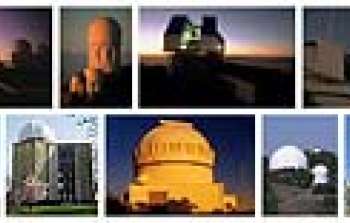sci08012 — Announcement
Program UpdateBuilding the System: A Phased Plan to Address the ReSTAR Recommendations and Priorities
July 31, 2008
In a previous issue of Currents, we summarized the recommendations of the ReSTAR (Renewing Small Telescopes for Astronomical Research) committee. The committee studied the needs of the US Community for current and future capabilities on small and mid-sized telescopes. The ReSTAR report provides a compelling case for the modernization of infrastructure and capabilities on 2- to 5-meter telescopes and increased access to these facilities. A number of capabilities are noted as already lagging the state-of-the-art, in particular, medium-resolution optical and near-IR spectroscopy. The number of observing nights needed to support high-quality research projects was found to be significantly higher than the current number of nights available through open-access channels. In addition, the evolution of other new facilities—in particular, LSST—was envisioned to further increase the demand for observing time and to drive a need for alternate modes of observing.
To address the needs articulated in the ReSTAR report, we are now assembling a coherent program that will (a) improve or modernize the infrastructure—observatories and telescopes—of the open-access system to ensure that the facilities are safe, reliable, and effective; (b) create new state-of-the-art instruments in the areas where the greatest impact can be made; and (c) increase access, if possible, by partnering with non-federal facilities that can offer desirable capabilities with an effective level of support. Over the past six months, the NOAO staff has been working to design such a program.
Based on guidance from our advisory and oversight committees and the NSF/AST staff, we have developed a proposed implementation plan that, in its initial phase, would build two new medium-dispersion optical spectrographs, one new near-IR spectrograph, and one new high-dispersion optical spectrograph. To expedite the delivery of these capabilities, two of the three proposed instrument designs are based on instruments that are already under construction or have been constructed by university groups for other facilities. In addition, we propose to add nights to the open-access system through new partnerships with non-federal facilities. We see this as the first of three 3-year phases in the implementation plan. The proposed plan, if implemented successfully, would address most of the recommendations and priorities of the ReSTAR report.
A white paper describing the proposed implementation plan is now available for public scrutiny and comment. Our intent is to develop the white paper into a proposal that will be submitted to the Astronomy division of the NSF in October. Although specific projects and partners are identified for phase 1, we would solicit community input, both ongoing guidance to the program and expressions of interest in participating, for projects that would be carried out in the two subsequent phases. Please send your comments on the white paper and the implementation plan described therein to currents@noao.edu.
Contacts
About the Announcement
| Id: |
ID
sci08012
|

